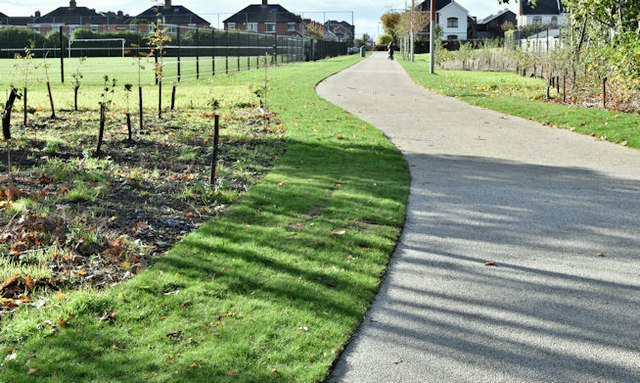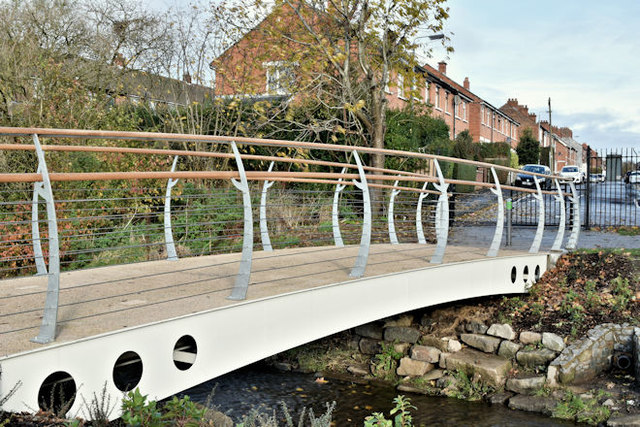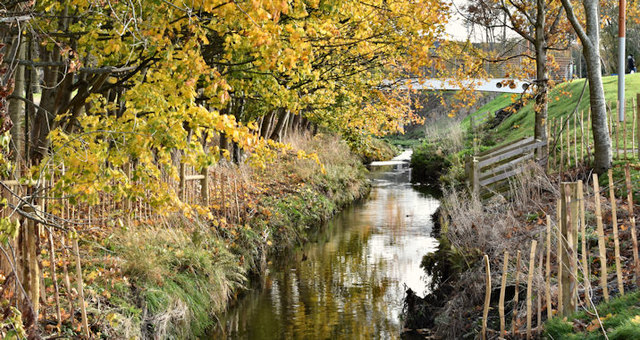Connswater Community Greenway (CCG) is an urban greenspace regeneration project in east Belfast transforming a blighted public space into a community asset. It consists of improvement works to a 9 km linear park connecting open spaces along the Connswater, Knock and Loop rivers. Alongside the recovery of neglected ecosystems, supporting residents’ health and wellbeing was a core objective of the regeneration project from the outset. The Greenway passes through 29 electoral wards, seven of which are within the top 25% most deprived wards in Northern Ireland. Community events and activities were organised throughout the project to create a sense of community and foster ownership of the greenspace, such as community clean-ups, volunteer gardening and walking groups.
The Greenway regeneration was a complex project with multiple partners and funding sources. The project was initiated from a 2005 Needs Analysis carried out by the East Belfast Partnership, and was later expanded to include significant flood alleviation measures after serious floods in 2007 and 2008.(1) The broad social purpose of the CCG is ambitious, as explained by a project evaluation:
‘In short, the Greenway exists to bring about dramatic and positive change to the physical environment and to people’s opportunities, health and lifestyles. People and communities which, for generations, have turned away from the dirty and neglected Connswater River system now have the opportunity to return and make the most of what has become a living landmark and a valuable, life-enhancing asset’ (2).
This project is featured as one of our healthy urban development case studies.
| Location | Belfast, Northern Ireland |
| Project type: | Urban greenspace regeneration |
| Project size: | 9 km of linear greenway, 5 km of remediated watercourses, 16 km of footpaths and cycleways and 13 ha of park space |
| Goals: | To improve the local environment and support health. |
| Date started: | May 2013 |
| Date completed: | September 2017 |
| Project cost: | £40m Funders: Big Lottery Funds Living Landmark Programme £23.6m, Belfast City Council £4m, Department for Communities £3.7m, Department for Infrastructure £8.7m |
| Stakeholders: | Belfast City Council, EastSide Partnership, the Northern Ireland Department for Infrastructure Rivers Agency and the Northern Ireland Department for Communities. Private sector partners: Phase 1) BSG Civil Engineering, McAdam Design, AECOM, Jacobs, Phase 2) ARUP, Farrans and The Paul Hogarth Company |
| Website: | www.connswatergreenway.co.uk |
Health and wellbeing
A summary of health-related strategies and achievements of the Connswater Community Greenway is shown in the tables below and aligned to the THRIVES framework (3), using information from project evaluations.
| Planetary health | Greenspace supports carbon sequestration and biodiversity. |
| Ecosystem health | 50 tonnes of rubbish were removed from the rivers. 9 km linear greenway improved. 3 hectares of semi-natural habitat were created and 1444 native trees planted. Improved water quality (from poor to moderate) on 5 km of remediated water courses, flood alleviation measures and management of invasive species. New cycle paths/footways (16 km) and bridges/crossings (23 new or improved) increase connectivity and walkability. |
| Local health | Reducing urban heat island effect through greenspace. New public art, community activities and six heritage and tourism trails. 2 new children’s playgrounds, 2 community gardens, 2 multi-use games areas, a civic square and improvements to four major parks. |
| Inclusion | Community engagement is seen as a key success by the CCG. In the early stages of the project there were events, surveys and face-to-face interviews with 300 residents, that were used to inform the project. The CCG seeks to promote physical activity in diverse population segments such as young mothers, unemployed and senior citizens. The programme also includes a number of school-based and community-based initiatives to promote usage. |
| Equity | Investment was targeted at east Belfast, an area with high levels of socio-economic deprivation. |
| Sustainability | The project is inherently driven by sustainability principles. A CEEQUAL (Civil Engineering Environmental Quality Assessment and Awards Scheme) award was targeted for the scheme at the ‘Very Good’ level, focusing on 1) creating semi-natural habitat, 2) control of invasive species and 3) native tree planting. |



Achievements
CCG is an excellent example of environmental improvements over a short period of time and it has won numerous national and international awards. Three-quarters of the project’s Key Performance Indicators (KPIs) were achieved by 2017.(2)
- The CCG has created a valuable community resource in what was a neglected space.
- The East Belfast Flood Alleviation Scheme (EBFAS) achieved its goal to protect 1700 properties from flooding risk.
- The Northern Ireland Environment Agency has reported an ecological and environmental improvement in the Connswater river system regarding water quality and improvements to the river corridor.
- The Connswater Community Greenway Trust (CCGT) has been established as a UK charity to ensure the ongoing legacy of the project for community benefit. The agreement reached with Belfast City Council provides management and maintenance plan for 40 years, ensuring the long-term sustainability of the achievements.
- The number of visitors to the CCG increased, as did play and recreation in the area (from 285 people per hour to 556).
There were some disappointing results from health-related measures identified by academic evaluations of the project (2,4) indicating that self-reported health, physical activity and use of active transport were slightly lower than the baseline measures at the time of project completion. However, detecting health impacts from changes to the physical environment may take a longer time to achieve than the monitoring period.
A study of the economic benefits of the greenway by Ruth Hunter and colleagues (5) evaluated seven areas: ‘(1) land and property values; (2) labour employment and productivity; (3) flood alleviation; (4) climate change; (5) health; (6) tourism; (7) quality of place (e.g. environmental aesthetics, provision of amenities)’. They reported the greatest value from local property value increases, healthcare savings and avoided flood damage and crime. In summarising the monetary value, they report:
‘the Benefit Cost Ratio of the project ranged from 2.88 to 5.81… In other words, for every £1.00 invested in the greenway, there would be approximately £2.00–6.00 returned. …after approximately ten years the greenway should pay for itself.’(5)
The study authors note that some of the effects of the greenway improvements, such as increased land and property values, could result in unwanted displacement and gentrification in east Belfast. They also report that their model assumes a linear cause and effect relationship that does not represent the complexity of changes brought about by such a project. For instance, they haven’t been able to capture benefits from behavioural changes related to food purchasing, play or building social capital. Further analyses could pick up these important potential impacts of the greenway.
Lessons learned
Among the main lessons learned are:
- Working with multiple partners effectively over a long time period was crucial for the project’s success.
- Fostering awareness and engagement among the community was important to increase usage and stewardship of the Greenway upon its completion. In addition to planned events, the CCG employed a successful communication strategy by using both online and traditional communication channels.
- The increase of visitors from outside areas shows how attractive those open spaces can be, which can also contribute to the local economy.
More information
- Simpson, S., 2011. Evaluation Report Reviewing Progress to March 2011. Connswater Community Greenway.
- Simpson, S., 2019. Evaluation Report: Final evaluation, reviewing progress and achievements on project completion, September 2017. Connswater Community Greenway.
- Pineo, H., 2020. Towards healthy urbanism: inclusive, equitable and sustainable (THRIVES) – an urban design and planning framework from theory to praxis. Cities Health 0, 1–19.
- Tully, M.A., Hunter, R.F., McAneney, H., Cupples, M.E., Donnelly, M., Ellis, G., Hutchinson, G., Prior, L., Stevenson, M., Kee, F., 2013. Physical activity and the rejuvenation of Connswater (PARC study): protocol for a natural experiment investigating the impact of urban regeneration on public health. BMC Public Health 13, 774.
- Hunter, R.F., Dallat, M.A.T., Tully, M.A., Heron, L., O’Neill, C., Kee, F., 2020. Social return on investment analysis of an urban greenway. Cities Health 0, 1–18.
